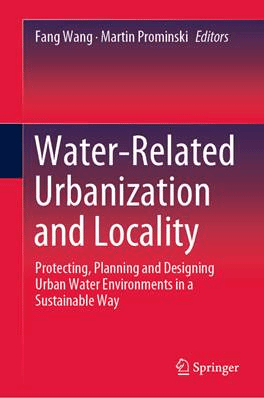NSFC-DFG(中德)城镇化与地方性合作小组是在中国国家自然科学基金委员会、德国科学基金会的共同资助下,由北京大学建筑与景观设计学院、海洋研究院汪芳教授与德国莱布尼兹汉诺威大学Martin Prominski教授共同建立,并担任组长。双方合作编著的《Water-Related Urbanization and Locality: Protecting, Planning and Designing Urban Water Environments in a Sustainable Way》在Springer Nature出版社正式出版。这是本合作小组有关“城镇化与地方性”主题的第二部书籍。该书的出版得到了中德科学中心(中国国家自然科学基金委、德国科学基金会共同成立)的项目资助。于2021年9月获得第三届“施普林格·自然:中国新发展奖”。

书籍官网链接:https://link.springer.com/book/10.1007/978-981-15-3507-9
水资源直接关系着人类的生存问题及人居环境可持续发展问题。水资源不合理利用引发的水资源污染、短缺以及自然灾害的加剧,制约着城镇、区域和国家的社会经济发展,对生态环境安全及人类的可持续发展造成威胁。如何在环境演变、城镇发展的过程中,实现水资源得到可持续开发利用,使水文化的地方性得以保持和丰富,成为当下生态环境保护、城市规划设计的一大挑战。
城乡建成环境的地方性是建立和维护公众自我认同和地方认同的关键。然而,在全球化和城市化进程的背景下,城市的同质化问题已经显现出来。此外,地方意识的消弭也严重影响到可持续发展。在区域文化景观的构成中,水不仅是重要的景观要素,而且支配并引导着景观的演变。人类生活生产过程中的水利用特征也成为地方性的重要体现。凸显场地特征的水景观,将很好地满足人们对美、娱乐休闲的需要以及城市的商业需求。如何在城镇化进程中留存和塑造地方性,也成为水空间规划设计的一大挑战。
目前,中国正处于新型城镇化转型阶段,面临着水资源人均占有率低、水资源分布不均、水污染严重以及滨水区景观单调等问题;德国基本上完成了城镇化,但面临着“再城镇化”的局面,同时也面临着水资源过度利用、水利基础设施过于庞大,统一规划发展的滨水区缺乏地方性等问题。基于上述考虑,针对当前解决地方和可持续发展问题的需要,本书重点关注以下问题:城市化背景下城市与水环境的关系是什么?如何在城市发展过程中合理保护和配置水资源?在设计城市水上空间时,如何保护和创造地方性?在建设城市基础设施时,如何可持续利用水资源?
由于水资源环境保护和利用、水空间规划和设计是一个跨学科、综合性的科学问题,本书邀请了中、德两国的规划、建筑、景观、地理、旅游、历史、生态、水文等相关领域的专家参与,针对以下三个主题发表见解:
① 新机遇:城市化进程中水环境保护与利用的挑战
New Opportunities: Challenges between Water Environment Protection and Utilization in the Process of Urbanization
② 新战略:城市化进程中水资源与水文化的可持续发展
New Strategies: Sustainable Development of Water Resources and Water Culture in the Process of Urbanization
③ 新探索:城市化进程中水主题的规划设计策略与地方文化发展
New Explorations: Water-related Planning and Design Strategies in the Process of Urbanization and Local Cultural Development
本书通过聚焦环境变化背景下,城镇化和地方性主题下的水资源探讨,致力于探索生态环境、经济和社会的可持续发展问题。就水资源问题,实现中、德的城镇化建设和地方性存续的经验的相互借鉴与促进。
Contents
Part I New Opportunities: Challenges between Water Environment Protection and Utilization in the Process of Urbanization
1. Locality Pattern Systems as Design Tools for Water-Related Open Spaces
Martin Prominski * and Kendra Busche
2. The Influence of Water Transportation Evolution on the Economic Development of Cities along the Beijing–Hangzhou Grand Canal since the Late Qing Dynasty
Fang Wang *, Chenge Gao, and Wenying Hu
3. Locality in Water-Related Urban Design: Dimensions and Examples
Carl Herwarth von Bittenfeld * and Joachim Rosenberger
4. Coastal Tourism City Development Planning Led by Water System Construction
Binyi Liu *, Wei Chen, Guangjia Zhang, Zhanying Zhu, and Jing Liang
5. Study on Water Resources Problems of Arid Areas under the Influence of Urbanization
Jianli Ding, Jinjie Wang *, Ligang Ma, and Wen Ma
Part II New Strategies: Sustainable Development of Water Resources and Water Culture in the Process of Urbanization
6. Water Environment Protection for Reservoirs in Mountainous Cities: A Case Study of Longjing Lake in Chongqing
Qiang He *, Xiaoliu Huangfu, Caihong Liu, and Ziwei Chen
7. Bottom-up or Top-down? The Water God Faith in Human–Water Relationships: A Case Study of the Beijing-Hangzhou Grand Canal in the Qing Dynasty
Fang Wang *, Haochun Li, Qingyin Liu, and Longjiang Du
8. Water Commoning: Testing the Bille River in Hamburg as a Space for Collaborative Experimentation
Antje Stokman *, Dagmar Pelger, Amelie Rost, and Dorothee Halbrock
9. Decentralized Stormwater Management: Experiences with Various Measures in Germany
Wolfgang Dickhaut * and Michael Richter
10. Flood Control and Evaluation Study of Small Watershed Units and Urban Topography Landscape for Wuhan City
Jing Wu * and Mengting Li
11. Tools for Designing Riverscapes Co-Creatively. Walk! Find Typologies! Design Spatial Visions!
Henrik Schultz *
12. Water as a Resource
Annette Rudolph-Cleff * and Simon Gehrmann
Part III New Explorations: Water-related Planning and Design Strategies in the Process of Urbanization and Local Cultural Development
13. Water-based Communication and its Impacts: A New Perspective on the Grand Unification of Imperial China
Bihu Wu *, Yanbo Wen, and Tingwei Lin
14. Water as a Primary Building Material of the City as Second Nature
Andreas Quednau * and Sabine Müller
15. Study on Spatial Planning Strategies of the Yellow River Floodplain Area in Xinxiang from the Perspective of a Resilient City
Chi Li * and Xinyu Ma
16. Assessing the Uniqueness of River Landscapes: The Lahn Case Study
Christian Albert *, Jana Brenner, Johannes Hermes, Dominik Metzger, and Julia Thiele
17. The Functions and Aesthetic Meaning of Water Scenes in Chinese Temple Gardens
Hui Wu, Hexian Jin *, and Qingqing Zheng
18. Study on Spatial Planning Methods of Urban Water Systems in the Arid Areas from an Ecological Perspective: A Case Study of Aksu, Xinjiang
Wenqi Lin *, Li Liu, Junhui Liang, Hui Yi, and Bin Liu
19. Statement on Flora and Fauna as Integral Components of Locality in Urban Areas
Rüdiger Prasse *
About the Editors

Prof. Fang Wang, Ph.D. is a Professor at the College of Architecture and Landscape and at the Institute of Ocean Research, Peking University, the Chinese Director of the NSFC-DFG Sino-German Cooperation Group on Urbanization and Locality (UAL), a registered urban planner, and an Associate Editor of Indoor and Built Environment. She has conducted substantial theoretical and practical research on "characterization, evolution and prediction of the locality of built environment in complex adaptive systems." Her representative accomplishments include works on urban and rural memory, geo-architecture and landscape, and cultural landscape security pat terns. She is the sole author or first editor of six monographs published by Springer Nature, each of which is available in more than 100 renowned libraries across six continents, including the Loeb Design Library Collection at Harvard University. She has directed seven projects subsidized by the National Natural Science Foundation of China. As the team leader, she won the First Prize of the Outstanding Achievement Award of Scientific Research in Colleges and Universities (Humanities and Social Sciences) in 2020, sponsored by the Ministry of Education of the People's Republic of China, the First Prize of the China Construction Science and Technology Award in 2017, sponsored by the Ministry of Housing and Urban-Rural Development of the People's Republic of China, as well as the Second Prize of the Land Resources Science and Technology Award in 2015, sponsored by the Ministry of Land and Resources of the People's Republic of China.



